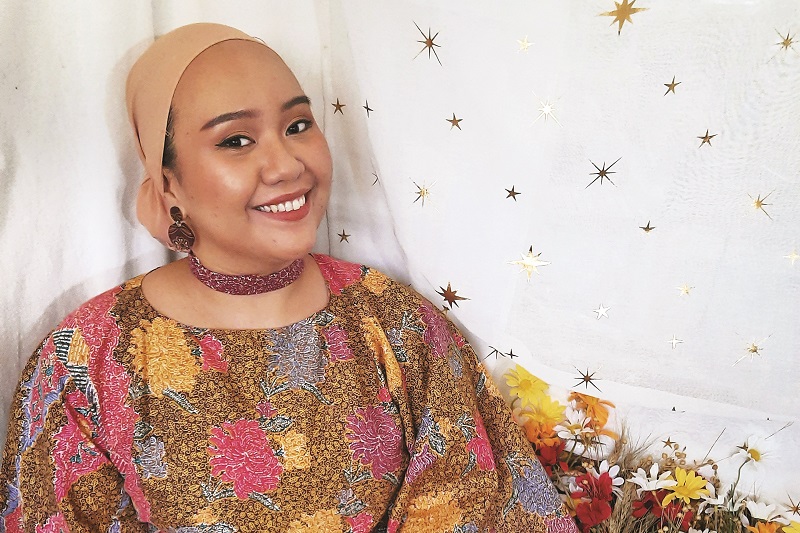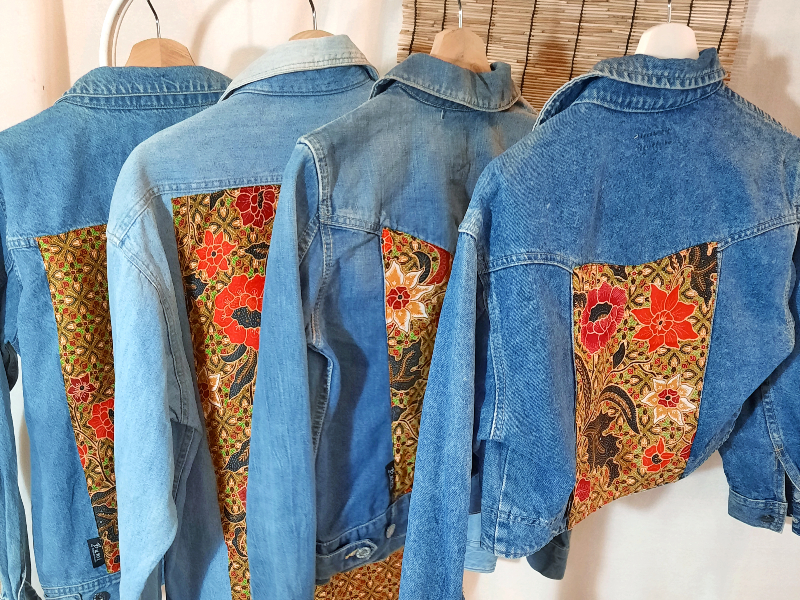
The Batik Life’s Bumi collection comprises upcycled denim jackets (All photos: The Batik Life)
It all began in 2017, when Hanan Anwar travelled to Indonesia on a family holiday. At the time, batik pareos were a booming trend and she was completely enthralled by their effortless style and the many prints available. She was such a fan that she brought 20 pieces back to Malaysia. “I thought, I’m not going to keep all 20, so why not sell some? That was how it started.
“I built a relationship with a couple of suppliers over there and it went from their offering what they already had to getting to choose the actual kain (fabric) myself to be made into pareos,” she says. Not being fully committed to the venture, she had starts and stops selling the items until she decided to come up with her own designs in 2019.
As a true lover of fashion, Hanan would challenge herself to try out various styles and spend an entire week wearing only one colour. “There was one week when I decided, you know what, let’s do batik. I wore batik to university all week, and then it turned into two weeks,” she says. Her collection of batik pieces grew with the help of a dorm mate’s mother, who tailored the fabric into designs she dreamt up.
hanan_anwar.jpg

Hanan named her business The Batik Life and its most unique product was also the first of her self-designed creations. “I’m passionate about batik, sustainability and entrepreneurship. I thought, ‘How do I combine all these things and make something productive?’” She was inspired by a Texan friend whom she met during a summer programme in Washington DC. “She had this jacket with floral prints sewn on the front, and I thought that was really cool. I looked it up and realised that people do a lot of patching with denim jackets, especially in the southern part of America.”
The Batik Life’s Bumi collection comprises upcycled denim jackets, updated with a batik panel that makes them uniquely Malaysian. As denim is such a thick fabric, and because Hanan is not very comfortable with a sewing machine, the batik bits are manually sewn onto the jackets. In 2019, she managed to sell 20 hand-stitched pieces at two pop-up bazaars.
The Batik Life has since grown to include a wide range of apparel, from dresses and pareos to cardigans and tops. Hanan works with a small group of tailors to bring her designs to life. With them, she hopes to incorporate a more holistic view of sustainability, which includes paying fair wages and ensuring transparency in all aspects of her business. “In the future, to be sustainable, I would like to work with more local artisans to produce things in small batches so we can reduce waste and make sure everyone is treated fairly,” she says.
20210223_133115-01.jpg

Troubled by the amount of waste created by her business, Hanan wants to repurpose the leftover bits of fabric. Although last year’s lockdown slowed production and made it difficult to source batik, she was able to take the time to refocus her efforts on reducing waste. “I asked the tailors to collect the kain lebih (excess fabric) and went home with bags and bags of them,” she recalls. She made scrunchies out of the larger scraps. As for the smaller pieces that would otherwise have gone into the bin, she poured clear resin on them to make them durable, then fashioned them into stylish earrings, necklaces and hairclips, selling some and gifting the others.
Another challenge Hanan faced in running her business was trying to ensure that her social media presence fully represented her brand. The one benefit of the Movement Control Order was that it afforded her time to build her online presence and launch her website last September. “I’m quite happy with how I’m growing on my online platform. I’ve slowly become more comfortable speaking to my audience,” she says.
As sustainability is one of the cornerstones of The Batik Life, the upcycled denim jackets are a key collection. “I call it slow fashion because it is sustainable and really slow to produce,” says Hanan. The vintage denim jackets are sourced from thrift stores and bundle shops and she has started working with a supplier who focuses on second-hand items and is able to identify the exact kind of denim jackets suitable for this purpose. “I’ve built a good relationship with her to the point that I can find really nice pieces. Also, I only take a specific kind. They have to be all plain and have side pockets because a lot of people like that. I also have to consider the different shades, as well as the thickness — this is Malaysia, so you don’t want the ones that are too thick for our heat.”
The Batik Life remains a part-time gig for Hanan, who has experience in project management, intercultural education and international relations. She currently works in intercultural education. Still, her passion for batik and fashion is quite apparent, and the business is very much a creative outlet for her.
“One of the industries with the biggest impact on the environment is fashion. The thing is, a lot of people don’t want to own a second-hand piece. So, I hope to add value to these pieces by using batik, making them something unique that is part of our cultural identity. These jackets are no longer second-hand clothing, they have a new life,” Hanan explains. In the future, she intends to create more sustainable fashion and repurpose other second-hand pieces. She also hopes to create more modern and daily wear with accents of batik.
This article first appeared on June 7, 2021 in The Edge Malaysia.


